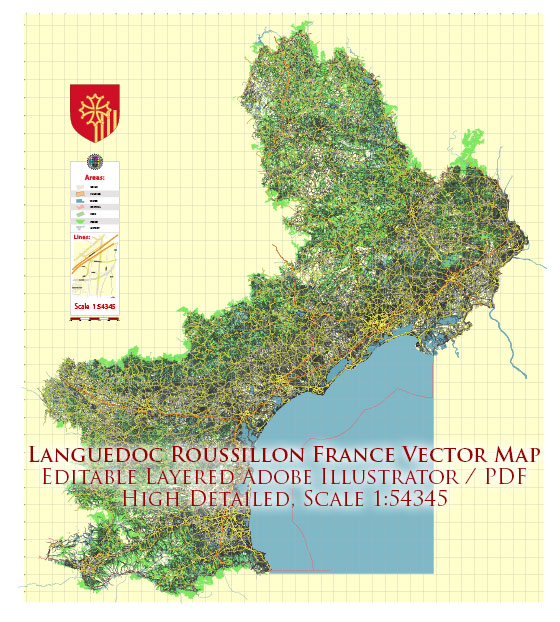Languedoc-Roussillon was a former administrative region in the southern part of France. However, please note that administrative divisions in France have been reorganized, and as of 1st January 2016, Languedoc-Roussillon is part of the larger administrative region called Occitanie.
Vectormap.Net provide you with the most accurate and up-to-date vector maps in Adobe Illustrator, PDF and other formats, designed for editing and printing. Please read the vector map descriptions carefully.
Geography: Languedoc-Roussillon, now a part of Occitanie, is located in the southern part of France. It is known for its diverse landscapes, ranging from the Mediterranean coastline to mountainous areas and plains. The region is bordered by the Mediterranean Sea to the east, the Pyrenees mountains to the south, and the Massif Central to the west.
Climate: The region generally experiences a Mediterranean climate with hot, dry summers and mild, wet winters. Coastal areas enjoy a milder climate due to the moderating influence of the Mediterranean Sea.
Cities and Towns: Languedoc-Roussillon was home to several notable cities and towns, including Montpellier (the regional capital), Nîmes, Perpignan, Carcassonne, and Beziers. Each of these places has its own unique history, architecture, and cultural heritage.
Culture and Heritage: The region has a rich cultural heritage influenced by its long history. Languedoc-Roussillon has been inhabited since ancient times, and various civilizations, including the Romans, Visigoths, and Moors, have left their mark on the area. The region is known for its medieval castles, Romanesque churches, and historic towns.
Cuisine: The local cuisine is influenced by Mediterranean flavors, featuring seafood, olive oil, herbs, and fresh vegetables. Some well-known dishes include cassoulet (a hearty bean stew), seafood dishes, and local wines from areas like the Languedoc wine region.
Tourism: Languedoc-Roussillon, with its diverse landscapes, historical sites, and cultural attractions, is a popular destination for tourists. The medieval fortress of Carcassonne, the Pont du Gard Roman aqueduct, and the beaches along the Mediterranean coast are among the region’s top attractions.
Natural Beauty: The region is characterized by its natural beauty, including the picturesque vineyards of the Languedoc wine region, the Cévennes National Park, and the Camargue Delta—a unique wetland area known for its wildlife, including flamingos and wild horses.


 Author: Kirill Shrayber, Ph.D.
Author: Kirill Shrayber, Ph.D.